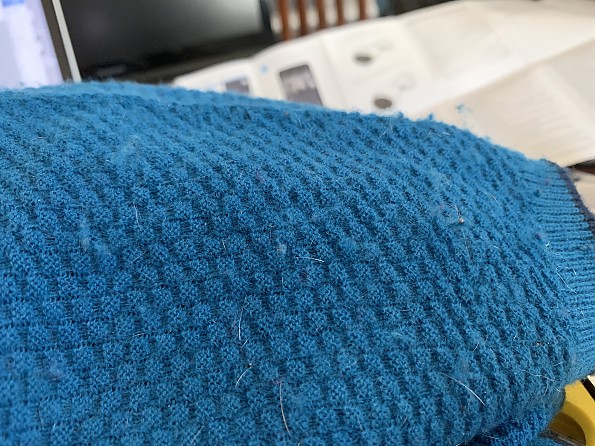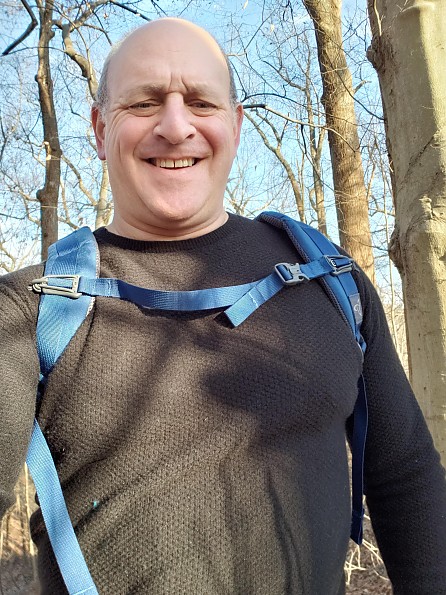Patagonia Men's Capilene Air Crew

A relatively loose, very stretchy, and ridiculously breathable base layer. Due to the loose weave, wind runs almost literally right through it. This is a combination wool/synthetic layer that provides great warmth (under a shell or in still air) and wicks moisture well. Durability...well, be careful with it. Good for a wide range of temperatures and conditions.
Pros
- Super comfortable
- Versatile
- Exceptional wool/synthetic combo
Cons
- Loose for a base layer
- Long sleeves
- Durability might be an issue
- Price
THE BASICS
A couple of years ago, Patagonia started selling a line of base layers it called "merino air." The fabric was a very stretchy combination of 51% merino wool and 49% synthetic Capilene, which is Patagonia's outstanding synthetic wicking base layer material. I picked up a pair of the Merino Air Bottoms and have enjoyed wearing them. Then, for no particular reason, Patagonia stopped selling it.
Last year, the knitted fabric returned, reincarnated as Capilene Air. Same knitted (Patagonia says "exploded") merino/capilene blend, same qualities as the last go-around.
As you will read as I run through how this performs, it is a unique kind of base layer, easily the most interesting and useful wool blend layer I have used. It is not without flaws, but one might easily overlook and tolerate those. First and foremost, wearing it makes me happy. The fabric is soft and feels amazing. That alone is a good reason to give this a really hard look. Read on...
FIT
Loose and forgiving. "Stretchy" sometimes implies that a shirt feels tight, "athletic fit." Not this one. It is a whole different level of stretch, consistent with the very loosely woven fabric. The body of the shirt is relatively long, and the sleeves are quite long—I often roll them up.
It depends on what you want in a base layer. if a lean and relatively tighter fit suits you better, you mind find this not to your liking. I encourage people to try it on and see how it feels.
DURABILITY
It's too early for me to evaluate durability for this particular shirt, which I picked up a few months ago. However, I have been wearing my merino air bottoms for a few years, and they are extremely similar if not the same product. Over time, the loose wool/Capilene woven fabric pills in higher-friction areas—look for that to happen under backpack shoulder straps.
So far, no pilling on the shirt, but I think it's too early to draw any conclusions, though I can say I haven't babied this shirt, and it hasn't torn or failed in any way. Also, if you're wearing this as an outer layer and doing any form of bushwhacking, snagging could be more problematic for this fabric than most alternatives. Other than pilling, the Merino Air Bottoms have done well and have no holes or tears, just pilling.
WARMTH
Similar to Patagonia's Nano-Air line, Capilene Air is great for a wide range of temperatures due to the fabric—both the blend and the open weave. Worn alone or over a wicking t-shirt, it's like wearing a very light fleece or wool sweater. Any amount of wind, it doesn't feel as warm.
Under a shell, without any outside air moving through it, this shirt feels very warm, more than most layers of a similar weight.
On a fairly pleasant 45-degree day, it bordered on too warm during a reasonably strenuous hike. The same shirt was plenty warm, worn alone under a Goretex shell, on an easier hike during this weekend's snow storm—low 30s and breezy.
WICKING
A strength. Patagonia's Capilene base layers tend to do a great job wicking moisture away from you. Their thermal weight Capilene is made with a similar concept, a loose weave that helps moisture get out, but this is even better at that.
Hiking on a cold morning, a nice layer of vapor/frost accumulated on the outer surface. That a 51% wool shirt does this well handling moisture? Amazing. It also dries out relatively quickly if it gets damp from rain or sweat, again, likely a function of the loose weave.
RECOMMENDED USES
Base layer for hard activity in the winter, particularly in very cold weather; for shoulder season and cool weather hikes where you want a combination of warmth and wicking; pull it on over a t-shirt on a cooler summit; wear it in the house on a chilly evening. My kids were debating whether it was a shirt or a sweater, which kind of captures it. This kind of warmth, wicking, and usefulness in warmer conditions makes it a layer you'll reach for first....a lot.
TESTING CONDITIONS
Several hikes over the last few months for the shirt. A couple years of cool to cold weather outings for the pants that I believe are the same or quite similar.
CONCLUSIONS
Don't worry about the durability or the long sleeves—I love this shirt. I wish it were less expensive, too, but I think it is well worth the price. and, Patagonia is generally very good about honoring its lifetime guarantee. I had some older, loose-knit expedition weight merino shirts from Patagonia that had a tendency to get big rips in the sleeves when pulling the shirt on and off—and Patagonia replaced them all. This fabric is quite a bit more durable than that. In many ways, it captures the best of both worlds for a wool/synthetic blend.
Very highly recommended.
Background
2-3 months of use for cool or cold weather hikes, dog walks, snow shoveling.
Source: bought it new
Price Paid: $105, with a website discount.
Feels comfortable. Arms are pilling. Costly.
Pros
- Lightweight
- Comfortable
Cons
- Pilling
- Cost
Been wearing for three weeks. Shirt is comfortable to wear all day, under another shirt or by itself. Crew neck is higher than my other shirts, but it is still comfortable. Washes well, and I like that it does not retain smells.
Bottom side of sleeves are pilling, even after light use. The price is really high—being my highest price baselayer. Seems to be an excellent overall design, but the fabric should not show really early wear signs. Cost to benefit is just average.
Background
Other merino base layers have not shown pilling so soon.
Source: bought it new
Price Paid: $129
Your Review
Where to Buy
You May Like
Specs
| Price |
Current Retail: $90.30-$139.00 Historic Range: $47.78-$139.00 Reviewers Paid: $105.00-$129.00 |








